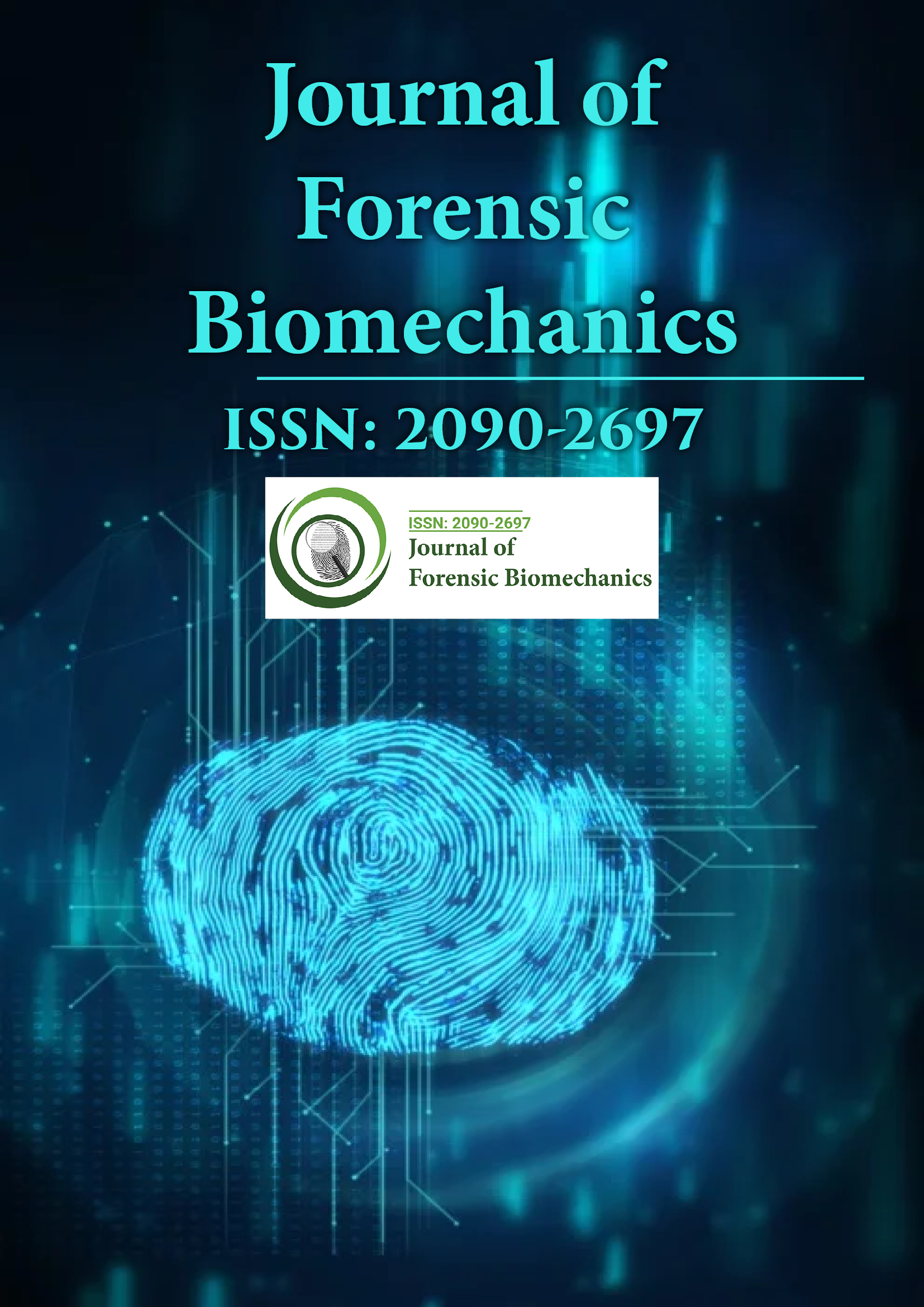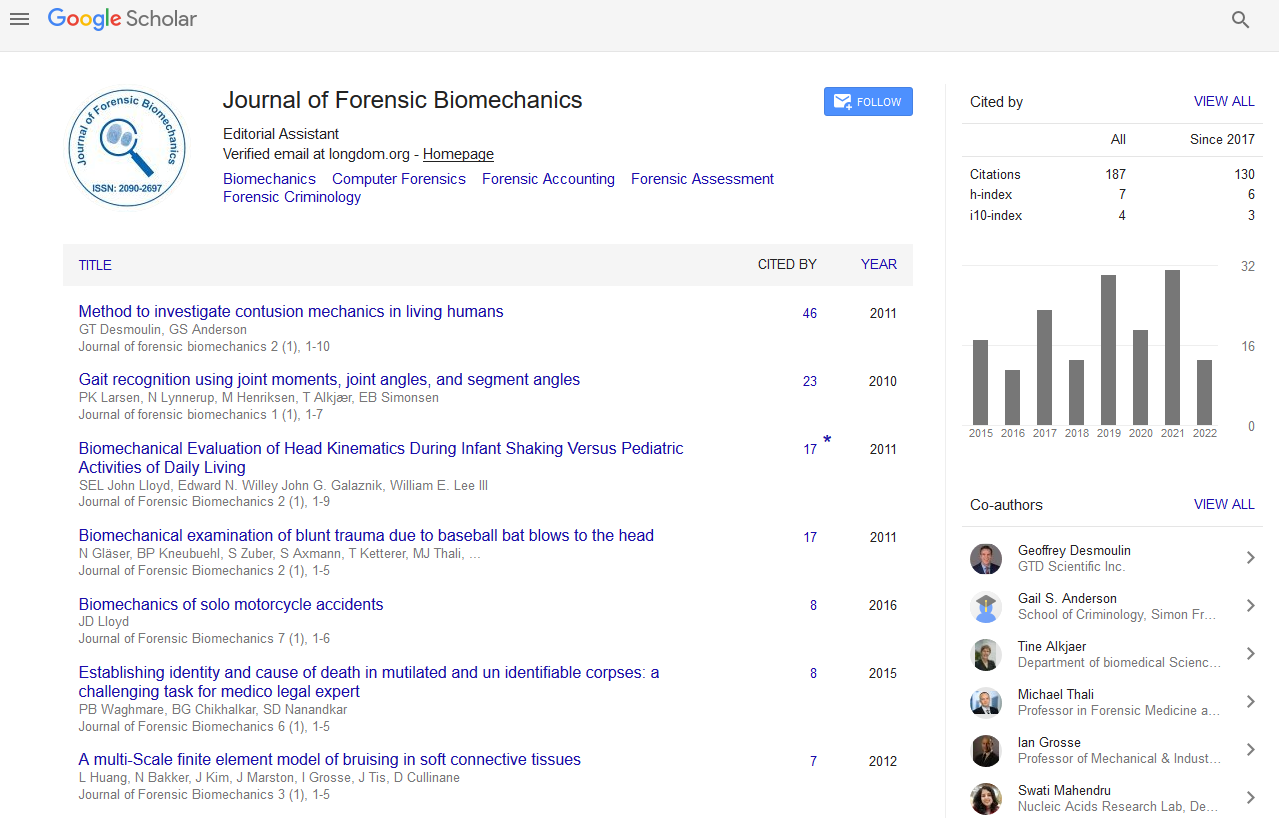Indexed In
- Genamics JournalSeek
- SafetyLit
- Ulrich's Periodicals Directory
- RefSeek
- Hamdard University
- EBSCO A-Z
- Geneva Foundation for Medical Education and Research
- Euro Pub
- Google Scholar
Useful Links
Share This Page
Journal Flyer

Open Access Journals
- Agri and Aquaculture
- Biochemistry
- Bioinformatics & Systems Biology
- Business & Management
- Chemistry
- Clinical Sciences
- Engineering
- Food & Nutrition
- General Science
- Genetics & Molecular Biology
- Immunology & Microbiology
- Medical Sciences
- Neuroscience & Psychology
- Nursing & Health Care
- Pharmaceutical Sciences
Opinion Article - (2025) Volume 16, Issue 1
Skeletal Fracture Patterns: Decoding Violence Through Biomechanics
John stave*Received: 01-Jan-2025, Manuscript No. JFB-25-28537 ; Editor assigned: 03-Jan-2025, Pre QC No. JFB-25-28537 (PQ); Reviewed: 17-Jan-2025, QC No. JFB-25-28537 ; Revised: 24-Jan-2025, Manuscript No. JFB-25-28537 (R); Published: 31-Jan-2025, DOI: 10.35248/2090-2697.25.16.517
Description
Skeletal fractures serve as pivotal evidence in forensic investigations, offering profound insights into the circumstances surrounding injuries or fatalities. Through meticulous biomechanical analysis, forensic experts can differentiate between accidental injuries and those resulting from violent acts, thereby reconstructing events with enhanced precision.
Bone fractures occur when applied forces exceed the bone's structural integrity. The nature of these fractures is influenced by several factors, including the type of force such as tension, compression, torsion, bending, or shearing the specific bone affected, its density, anatomical location, and the direction and magnitude of the applied force. For instance, bending forces might result in transverse fractures, while torsional forces often cause spiral fractures. Understanding these distinctions is decisive in forensic contexts, as they can indicate the nature of the incident leading to the injury.
Certain fracture patterns are particularly indicative of violent encounters. Blunt Force Trauma (BFT), resulting from impacts with broad-surfaced objects, can lead to complex fracture configurations, such as radiating and concentric patterns. The presence of multiple fractures at various stages of healing may suggest repeated episodes of violence. Sharp Force Trauma (SFT), inflicted by pointed or edged instruments, produces incised wounds and distinctive cut marks on bones; the depth, length, and location of these marks can provide information about the weapon used and the nature of the assault. Projectile trauma, such as injuries from bullets, creates unique fracture patterns, including entry and exit wounds with beveling on bones, aiding in determining the projectile's trajectory and caliber.
Biomechanical analysis of skeletal fractures is instrumental in various forensic scenarios. In homicide investigations, identifying fracture patterns consistent with defensive wounds or repeated trauma can suggest foul play. In accident reconstruction, analyzing fractures resulting from vehicular accidents helps determine the mechanics of injury and corroborate witness statements. In mass disaster analysis, such as natural disasters or terrorist attacks, examining skeletal fractures aids in understanding the forces involved and the positions of victims at the time of the incident.
Recent technological advancements have enhanced the precision of biomechanical analyses. Finite Element Analysis (FEA), a computational method, simulates how bones respond to various forces, allowing for detailed predictions of fracture patterns under specific conditions. Advanced imaging techniques, such as CT scans, enable the creation of accurate 3D models of bones. These models can be 3D printed for tactile examination or used in virtual simulations to study fracture mechanics.
While biomechanical analysis provides valuable insights, ethical considerations must be addressed. Ensuring that human remains are handled with dignity and respect throughout the analysis process is paramount. Obtaining appropriate consent and being mindful of cultural practices related to the treatment of human remains are essential to maintain ethical standards.
Effective biomechanical analysis of skeletal fractures often requires collaboration among various disciplines. Forensic pathologists work alongside anthropologists to correlate soft tissue injuries with skeletal trauma. Engineers provide expertise in mechanical forces and material properties to enhance the understanding of fracture mechanics. Law enforcement collaborates to ensure that biomechanical findings are integrated into the broader investigative framework, aiding in case resolution.
In conclusion, biomechanical analysis of skeletal fracture patterns is indispensable in forensic science. It enables experts to decode the circumstances surrounding injuries, differentiate between accidental and intentional harm, and reconstruct events with greater accuracy, thereby contributing to the pursuit of justice.
Citation: Stave J (2025). Skeletal Fracture Patterns: Decoding Violence through Biomechanics. J Forensic Biomech. 16:517.
Copyright: © 2025 Stave J. This is an open-access article distributed under the terms of the Creative Commons Attribution License, which permits unrestricted use, distribution reproduction in any medium, provided the original author and source are credited

